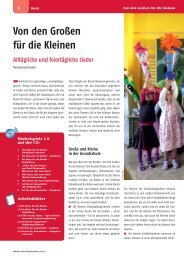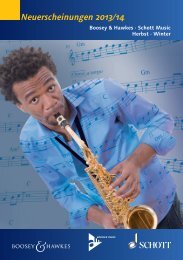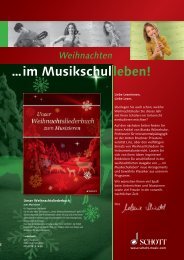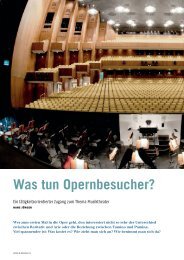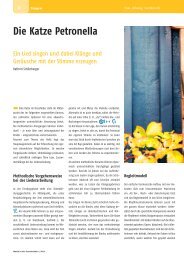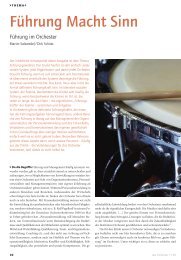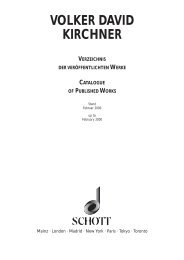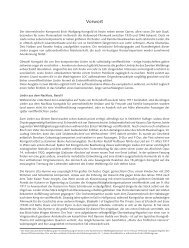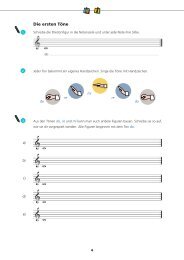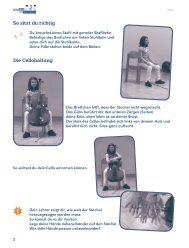HANS WERNER HENZE - Schott Music
HANS WERNER HENZE - Schott Music
HANS WERNER HENZE - Schott Music
Erfolgreiche ePaper selbst erstellen
Machen Sie aus Ihren PDF Publikationen ein blätterbares Flipbook mit unserer einzigartigen Google optimierten e-Paper Software.
cept of music theatre: he named Mozart and Verdi<br />
at the head of the list of its representatives and role<br />
models in 1966, the year of the world premiere of The<br />
Bassarids, and defined its distinctive character as being<br />
“that the actions on stage have their origins in the<br />
music and it is the music which provides gravity and<br />
expression […]. All internal emotions, atmospheres<br />
and situations – right down to the physical movements<br />
themselves – are anticipated by the orchestra and the<br />
music ‘is aware’ of the visual-scenic facet because the<br />
scene is intrinsically a visual transformation of the music.”<br />
Henze is distinguished as “homme de<br />
lettres” through his wide<br />
range of renowned<br />
librettists and<br />
literary adaptations<br />
for his<br />
stage works<br />
alone. Alongside<br />
his great<br />
literary affinity,<br />
his political<br />
commitment<br />
stands on an equal<br />
footing as manifested<br />
by a series of stage<br />
works with clear political<br />
themes<br />
and texts by<br />
Gastón<br />
Salvatore,<br />
Hans Magnus Enzensberger and Edward Bond from<br />
1968 onwards. His idea for Pollicino originates from<br />
his cultural-political activities, for example the festival<br />
“Cantiere Internazionale d’arte” in Montepulciano<br />
which he established in 1976. In addition to this scenic<br />
fairy tale for children, he has in 2010 returned to music<br />
theatre for and with young persons in Gisela oder:<br />
Die merk- und denkwürdigen Wege des Glücks, his current<br />
project for the stage in collaboration with Michael<br />
Kerstan.<br />
Henze is a composer who is completely undogmatic in<br />
his utilisation of both the twelve-tone scale and tonal<br />
melodies. Peter Petersen once coined the extremely<br />
apt pair of definitions “free dodecaphony – latent diatonics”<br />
to describe the environmental frontiers of his<br />
music in which both twelve-tone scales and diatonic<br />
melodies find their place. His free utilisation of harmony<br />
still permits the use of thirds, even within<br />
complex twelve-note structures. His range of<br />
speaking, singing, dancing and pantomiming<br />
dramatic figures all have a common factor:<br />
they are all in effect reflected, characterised<br />
and commented on by the orchestra<br />
with the aid of specific instruments<br />
and leitmotivs. In his more recent<br />
and current new works for the<br />
stage, Henze has evolved his<br />
own definitive personal style<br />
which is both dramatically<br />
effective and attractive for<br />
audiences.<br />
7



